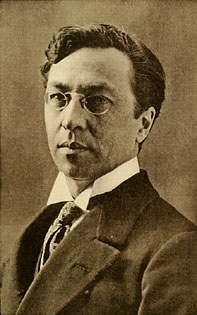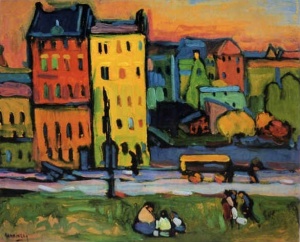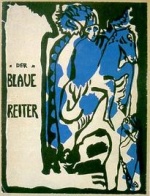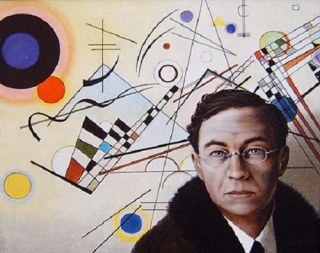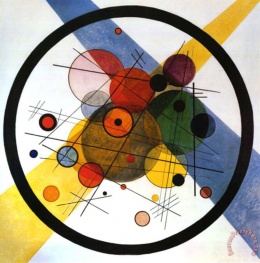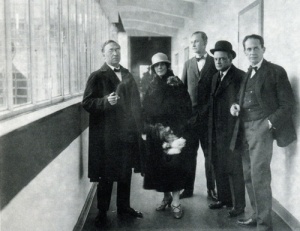Wassily Kandinsky
UNDER CONSTRUCTION
UNDER CONSTRUCTION
Wassily Kandinsky (Russian: Васи́лий Васи́льевич Канди́нский) was a Russian abstract expressionist painter and Theosophist. He wrote a hugely influential book, Concerning the Spiritual in Art, and taught at the Bauhaus.
Early life and education
Wassily Wassilyevich Kandinsky was born on December 4, 1866 in Moscow. His father, a wealthy tea merchant, was from an aristocratic family. In 1871 Wassily's family moved to the Crimea, and the boy attended school in Odessa. He excelled in his studies, and returned to Moscow in 1886 to study law and political economy. After he was awarded a degree in 1892, he taught jurisprudence at Moscow university. His career path in academia seemed to be well established when he "turned down the offer of a professorship at the University of Dorpat in Estonia and went instead to Munich to study painting."[1] As a young boy he had always loved music and art - playing piano and cello, and painting in oils. "Art and music, ranging from traditional Russian religious icons and Rembrandt oils to a performance of Wagner's Lohengrin, left profound impressions on him... An 1895 Moscow exhibit exposed Kandinsky to the French Impressionists, and his feelings upon seeing Monet's Haystack seemed to predict the destiny that awaited him."[2]
Artistic career
Because young artists in Munich in the 1890s were exploring abstract, primitive, oriental, and medieval styles in the Jugendstil movement, Kandinsky had the opportunity to move in avant-garde art circles while he pursued traditional training. In 1901 he broke away from the academy to form an artists' association called the Phalanx which gave him an outlet for exhibition. He also gained experience in teaching art and built a reputation that helped him into major exhibitions like the 1902 Berlin Secession and the Salon d'Automne in Paris in 1904. He began to travel to Germany, Italy, Holland, Tunisia, and France during 1903-1908, and developed his own style. Back in Munich, "the impact of the Fauvist color, combined with a primitiveness and directness attributable to his Russian heritage, the artist began producing major expressionist landscape paintings." He organized the Neue Künstler Vereinigung [NKV, the New Artists' Association] in a revolt against the Munich Secession. After 1911, his continued movement toward abstraction led to a split in the group, and Kandinsky, with Franz Marc, formed Der Blaue Reiter [the Blue Rider]. They published a journal, called an almanac, that emphasized spiritual reality expressed in diverse styles of art. During this same period, Kandinsky was writing his Über das Geistige in der Kunst, or Concerning the Spiritual in Art, which was published in 1911.[3]
Concerning the Spiritual in Art
Famous paintings
Bauhaus
Theosophical Society involvement
Later years
Additional resources
The Union Index of Theosophical Periodicals lists 9 articles by or about Kandinsky.
- WassilyKandinsky.net offers 511 paintings, 91 photos, biography, books, videos, quotations, and more.
- Wassily Kandinsky Natal Horoscope at Khaldea.
Articles
- Art, Theosophy, and Kandinsky by John Algeo
- Kandinsky's Thought Forms and the Occult Roots of Modern Art by Gary Lachman
- Kandinsky and Theosophy by Catherine Wathen
Video
- Kandinsky, Spiritual Insight, and Abstract Art by Dan Noga
Notes
- ↑ Richard Stratton, "Preface to the Dover Edition" Concerning the Spiritual in Art (New York: Dover, 1972), v.
- ↑ Richard Stratton, "Preface to the Dover Edition" Concerning the Spiritual in Art (New York: Dover, 1972), v.
- ↑ Richard Stratton, "Preface to the Dover Edition" Concerning the Spiritual in Art (New York: Dover, 1972), vi-viii.
- ↑ Mikey Smith, "Wassily Kandinsky: 8 of the Abstract Painter's Most Famous Works and Facts about His Life" Daily Mirror December 16, 2014 on Daily Mirror website.
